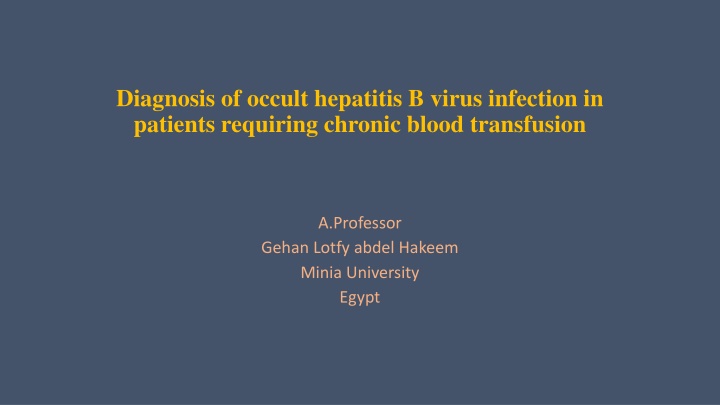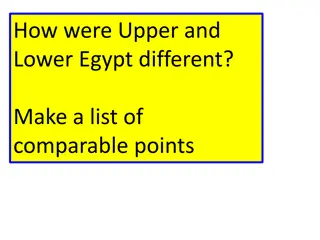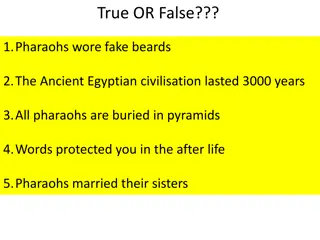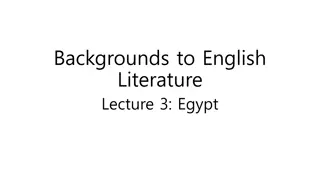
Occult Hepatitis B Virus Infection in Chronically Transfused Patients
Dive into the world of occult hepatitis B virus infection, its prevalence in Egypt, clinical impacts, and diagnostic methods explored by experts from Minia University, Egypt.
Download Presentation

Please find below an Image/Link to download the presentation.
The content on the website is provided AS IS for your information and personal use only. It may not be sold, licensed, or shared on other websites without obtaining consent from the author. If you encounter any issues during the download, it is possible that the publisher has removed the file from their server.
You are allowed to download the files provided on this website for personal or commercial use, subject to the condition that they are used lawfully. All files are the property of their respective owners.
The content on the website is provided AS IS for your information and personal use only. It may not be sold, licensed, or shared on other websites without obtaining consent from the author.
E N D
Presentation Transcript
Diagnosis of occult hepatitis B virus infection in patients requiring chronic blood transfusion A.Professor Gehan Lotfy abdel Hakeem Minia University Egypt
Authors: Prof. Salah Mahmoud Saleh Professor of Pediatrics, Faculty of Medicine, Minia University Prof. Sayed Fekry Abdelwahab Professor of Microbiology and Immunology, Faculty of Medicine, Minia University Dr. Gehan Lotfy Abdel-Hakeem Assistant Professor of Pediatrics, Faculty of Medicine, Minia University
Agenda Hepatitis B In the World Structure of Hepatitis B virus HBV Antigens HBV serology interpretation Clinical outcomes of Hepatitis B infections. Occult hepatitis B virus Definition Molecular Basis & Mechanism Diagnosis of OBI Prevalence : Egyptian situation Clinical Impacts of OBI Prevention Research presentation
Hepatitis B In the World Two billion people have been infected (1 out of 3 people). 400 million people are chronically infected. 10-30 million will become infected each year. An estimated 1 million people die each year from hepatitis B and its complications. Approximately 2 people die each minute from hepatitis B. 4
Hepatitis B Diagrammatic representation of the hepatitis B virion and the surface antigen components Hepadnaviridae family DNA virus Double-shelled particles Outer lipoprotein envelope (surface Ag) Inner viral nucleocapsid (core) Seven genotypes. Four major subtypes. All HBV subtypes share one common antigenic determinant - "a. EM of Hepatitis B viron Thus, antibodies to the "a" determinant confer protection to all HBV subtypes.
Structure of hepatitis B virus Dr.T.V.Rao MD 6
HBV Structure & Antigens Dane particle HBsAg = surface (coat) protein ( 4 phenotypes : adw, adr, ayw and ayr) HBcAg = inner core protein (a single serotype) HBeAg = secreted protein; function unknown Dr.T.V.Rao MD 7
HBV serology interpretation Acute infection HBsAg positive and anti-HBcAg IgM Rarely, IgM anti-HBc only marker Usually seen in acute fulminate Hep B Chronic infection HBsAg positive and anti-HBcAg Previous Infection HBsAg negative anti-HBs positive IgG anti-HBc positive
Clinical outcomes of Hepatitis B infections . Clinical outcomes of acute hepatitis B infection. (Redrawn from White DO, Fenner F: Medical virology, ed 3, New York, 1986, Academic Press
Definition of occult hepatitis B infection (OBI) The presence of HBV DNA without HBsAg, with or without the presence of HBV antibodies outside the acute phase window. The presence of HBV-DNA in the liver tissue of individuals who test negative for HBsAg regardless of the detection of HBV-DNA in the serum is defined as occult HBV infection.
Mode of transmission HBV infection can be transmitted through: Contact with contaminated blood. Mother-to-child transmission. Unprotected sexual intercourse. Post transfusion
Mode of infection Hepatitis is common even after practicing the stringent donor selection criteria and screening the blood for HBsAg. This is because a considerable number of HBV infected donors remained undiagnosed if only HBsAg is used for screening.
Serological pattern of OBI HBsAG - & HBV DNA + 80% 20% Seropositive OBI Seronegative OBI ( anti-HBc+ (+/-) anti-HBs+) ( anti-HBc - , anti- Hbs -) higher DNA level lower DNA level
Schematic conditions leading to different seropatterns of OBI HBsAg lost after self-limiting acute hepatitis Anti-HBV never present (Iry occult infection) Seronegative Anti-HBc negative Seropositive Anti-HBc positive OBI HBsAg lost after years of chronic carriage Anti HBV antibodies progressively disappear over time
Diagnosis of OBI Gold Standard : Analysis of liver tissue and blood for HBV DNA HBV DNA in blood by nested-PCR, real-time PCR, and transcription based mediated amplification (TMA) Anti-Hbc is a less than ideal surrogate marker when HBV DNA measurement is not feasible.
Schematic representation of possible clinical impacts of occult HB infection Transmission Of HBV infection HCC OBI HBV development reactivation Liver disease progression
Aim of the work The aim of this work was to detect the presence of occult hepatitis B virus infection among frequently blood transfused Egyptian pediatric patients
Patients and methods This study was carried out in the period from May 2013 to March 2014. Forty-five patients with different etiologies were randomly selected from regional blood bank while 12 positive known HBV+ve patients were enrolled as controls. Twenty-four out of the 45 cases (53.4%) were males while 21 (46.6%) were females. In the 12 control cases 7 (58.3%) were males and 5 (41.7%) were females. The age of the subjects and controls ranged from 6 months to 18 years.
Patients and methods Inclusion criteria: Subjects negative for HBsAg Frequently transfused children (previous 6 transfusions or more)
Patients and methods All patients and controls were subjected to: A full medical history included different variables: Age. Gender. Residence. Frequency of blood transfusion in last year. Presence of any liver disease. Positive family history of HBV infection. Positive family history of repeated blood transfusion. Vaccination history for HBV including the obligatory vaccination and any booster doses.
Patients and methods All subjects were completely examined clinically with stress on: Signs of liver affection such as jaundice, hepatomegaly and splenomegaly. The study was explained to all participants using the consent form.
Patients and methods All cases and controls were tested for: HBV-DNA (PCR). Anti HBsAg. Anti HBcAb. Anti HCV Ab. Serum ferritin. Serum ALT and AST. Blood Urea and serum Creatinine. CBC.
Patients and methods Blood sample collection and storage Three to five ml of venous blood were collected in sterile tubes, and centrifuged at 3000 rpm for 10 min. The sera were collected in two screw capped sterile cryovials. The samples were stored at -20 C until PCR analysis and other testing. The samples were taken at least 15 days after last blood transfusion. Serological and molecular detection of HBV Serological diagnosis of HBV Detection of HBV surface antigen Detection of HBV core antibody
Patients and methods Blood sample collection and storage Three to five ml of venous blood were collected in sterile tubes, and centrifuged at 3000 rpm for 10 min. The sera were collected in two screw capped sterile cryovials. The samples were stored at -20 C until PCR analysis and other testing. The samples were taken at least 15 days after last blood transfusion. Serological and molecular detection of HBV Serological diagnosis of HBV Detection of HBV surface antigen Detection of HBV core antibody
Patients and methods Molecular assay HBV-DNA Detection For each patient who was negative for HBsAg, plasma was explored for the presence of HBV-DNA by DNA Extraction and PCR amplification. DNA Extraction Viral DNA was extracted from 150 l of plasma, DNA samples were stored at -20 C. Nested-PCR was used to detect HBV-DNA in the plasma using a thermal cycler.
Patients and methods PCR amplification The sequences of the primers used in the Nested PCR were as follows: Outer-YMDD-F: 5 -GGTTATCGCTGGATGTGTCTGC-3 (22):365- 386 Outer-YMDD-R: 5 -CCACAATACGTTGACAGACTTTCC-3 (24): 980-1004 Inner-YMDD-F: 5 -CTCTTCATCCTGCTGCTATGCCTC-3 (24): 404- 425 Inner-YMDD-R: 5 -TGGTAACAGCGCTAAAAAGGGACTC-3 (25): 781-805.
Patients and methods Detection of PCR products The amplified products were visualized in 1% agarose gel stained with Ethidium bromide. We used HBV-DNA positive controls from HBV-DNA positive patients and negative controls containing no template and/or water at each PCR testing. The cutoff of HBV DNA detection was 5 IU/ml. All samples were tested for HBV-DNA detection using nested-PCR assay. We regarded the cases that showed positive results in duplicate.
Table (1): Demographic and clinical characteristics of the studied patients and controls. Results parameter Cases, n=45 (%) Controls, n=12 (%) p Age Range 3-17 6-18 0.44 Mean SD 10 4 11 3.6 Gender Male 24 (53%) 7 (58%) 0.76 female 21 (47%) 5 (42%) Positive family history of frequent 19 (42%) 0 (0%) 0.006** transfusion Positive family history of HBV infection 2 (4%) 0 (0%) 0.46 Positive routine HB vaccine 45 (100%) 12 (100%) 1 Presence of Positive 15 (33%) 9 (75%) 0.01* hepatomegaly negative 30 (67%) 3 (25%) Presence of Positive 19 (42%) 4 (33%) 0.56 splenomegaly negative 26 (58%) 8 (67%)
Table (2): Lab data for studied patients and controls parameter Cases, n=45 (%) Controls, n=12 (%) P value Negative 18 (40%) 0 (0%) PCR 0.001** Positive 27 (60%) 12 (100%) HBsAg Positive 0 (0%) 12 (100%) 0.001** negative 45 (100%) 0 (0%) HBcAb Positive 13 (29%) 12 (100%) 14 (31%) 0 (0%) negative 0.001** Not done 18 (40%) 0 (0%) HCVAb Positive 13 (29%) 6 (50%) 0.17 negative 32 (71%) 6 (50%) Serum ferritin (ng/ml) Range 6:7485 14:42 0.001** mean SD 2170 1547.8 28 9.9 AST Range 14:218 15:33 0.005** (IU/L) mean SD 59 47.2 22 5.7 ALT Range 8:245 12:39 0.001** (IU/L) mean SD 63 56.4 23 7.8 Blood urea Range 13:50 46:65 0.24 (mg/dl) mean SD 27 8.5 56 6.3 Serum creatinine Range 0.2:0.9 0.8:1.7 0.001** (mg/dl) mean SD 0.5 0.16 1 0.3 HB level (g/dl) Range 6:10 10:13 0.09 8 1.1 12 0.9 mean SD
AST LEVEL IN PATIENTS AND CONTROL AST LEVEL IN PATIENTS AND CONTROL
Table (3) comparison between HBcAb positive and negative occult HBV cases regarding clinical data HBcAb positive HBcAb negative p Parameter n=13 (%) n=14 (%) Age (years) 11 4.1 9 3.9 0.31 Male 7 (54%) 7 (50%) Gender 0.84 Female 6 (46%) 7 (50%) Frequency of Bl. 16 4.1 13 5.3 0.13 Transfusion (No/Year) Presence of Hepatomegaly 5 (38%) 5 (36%) 0.88 Presence Of Splenomegaly 5 (38%) 6 (43%) 0.82
Table (4): Comparison between HBcAb positive and negative occult HBV cases regarding Laboratory data HBcAb positive HBcAb negative parameters p n=(13) n=(14) Negative 0 (0%) 14 (100%) PCR 0.82 13 (100%) 0 (0%) Positive Positive 6 (46%) 1 (7%) HCVAb 0.02* negative 7 (54%) 13 (93%) Serum ferritin 2605 1923.3 1720 1029.7 0.15 AST 60 38.1 68 66.2 0.7 ALT 77 61.2 72 67.6 0.86 Blood urea 26 7.3 25 7.6 0.89 Serum creatinine 0.5 0.16 0.5 0.17 0.56 HB level 8 1.3 8 1.1 0.68
Hepatitis C virus infection prevalence in occult hepatitis B virus infection group
Conclusion The risk of acquiring occult hepatitis B virus infection is high in studied children who received multiple blood transfusions. Despite obligatory HBV vaccination schedules, chronically transfused patients were still at high risk of acquiring infection. Screening such at-risk patients with HBsAg is not enough and PCR screening is recommended. Also, blood donors screening for HBsAg reduces, but does not abolish, the risk of transfusion-transmitted HBV infection.
Conclusion A high OBI prevalence rate (60%) was found among frequently blood transfused Egyptian children. The frequency of hepatitis C virus infection increase in those with occult hepatitis B infection.
Recommendations: Based on our findings, we recommend the following: Frequently transfused children must be regularly screened for OBI by a sensitive PCR for HBV-DNA. Hepatitis B surface antigen negative blood donors should be screened to exclude HBV-DNA positive ones. Prospective studies with larger number of such patients are important to gain more insight into this important subject

![[PDF⚡READ❤ONLINE] Tutankhamun's Trumpet: Ancient Egypt in 100 Objects from the](/thumb/20549/pdf-read-online-tutankhamun-s-trumpet-ancient-egypt-in-100-objects-from-the.jpg)




















